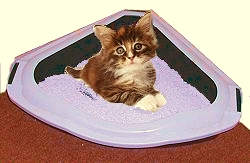Cat litter

Although cats have been domesticated for a long time, the cat litter as we know it is a relatively new invention. It dates from about the 1940s as the trend for indoor cats became more established. In England, many cats are outdoor cats, being allowed free access to the garden. In the past, and even today, in England many people put the empty milk bottles and the cat out for the night. Cats were expected to use the garden for their toilet needs (or the neighbour's prize delphiniums, but that is another matter). This is not to say that litter trays were never used before the 1940s; some people used cardboard boxes filled with old newspapers, home-made improvisations were the rule.
The first cat litter to be commercially produced was made from clay. Today, there are many varieties of litters you can choose from. They fall into four major categories: regular clay, scoopable, paper and and wheat and plant based.
Clay - regular clay litter is the cheapest and is still widely used. However, clay litter is less absorbent, which means that not only does not clump but also litter starts to smell very quickly. In an not entirely effective attempt to work around this, some brands of clay litter come scented or with other odor controls. Nevertheless, clay litter has to be changed frequently.
Scoopable - scoopable litters are usually based on silica gel and are very absorbent. Some manufactures claim that their litter can absorb up to 40 times its weight. The litter forms into clumps which can be scooped and replaced by fresh litter, which means that you do not need to change the lot every time. Although silica gel based litters cost more than regular clay, because you add small amounts each time, in a long run it may save money.
Paper based - these are usually made from recycled paper. Many of the brands are scoopable, and they all are biodegradable, which means you can flush it down the toilet. The litter is very soft so it is recommended for cats with injured feet. However, the litter is messy so it can be hard work for everyday use. On the other hand, you can feel you are doing your bit for the planet!
Wheat and plant based - these litters are the most natural. They do work well and they are some peoples first choice. They are less smelly and dusty than regular clay litter, but they are also a bit more expensive. Among the natural plant based litters, there are the sawdust litters. These, depending on the brand, may be clumpable or not. The pellets of different brands also may vary in size. Sawdust naturally neutralizes the smell of ammonia from cat urine, and the wood has anti-bacterial and anti-septic properties. If you are allergic to pine or have asthma, this product may make your condition worse.
More specialized litters are available. For example, a special 'PH' litter which changes colour with the acidity of the urine. This type of litter is great when your cat has recurring urinary infection. The litter will help you to spot the development of a urinary infection. Your vet will be able to advise where to get this particular litter from.
What litter should I buy for my cat?
If you have just got your cat it is best to use the litter she is used to, at least until she gets established in the house. Remember, you might have your own preferences for which litter to buy, but the casting vote goes to the user - your cat.
There is a phenomenon known as litter aversion, which is a common cause of house-soiling. Although litter aversion may be related to the type of the litter used, more often there are other factors involved, the most common being:
- inadequate cleaning (some cats are very fastidious and require almost lierfectly clean litter every time they use it)
- on the other hand, some cats actually dislike litters which are too clean
- learned aversion - when the litter tray is associated with something unlileasant. For examlile, if the cat suffers from a urinary tract infection, it may start associating the litter tray with urinary liain. Also because cats are stationary on the litter tray, owners may be temlited use this oliliortunity to ambush the cat - for examlile to force liills down its throat. The short-term benefits of this strategy are soon outweighed by the difficulty in liersuading the cat that behind the sofa is not a better and safer toilet sliot.
- liners are great and many owners find them very convenient. However, cats which like to scratch their litter about may get their claws caught in them which might cause them to seek alternative facilities.
- the litter tray is not filled to the right amount - cats like to cover their faeces and if there is not enough litter they will not be able to do that to their satisfaction.
- the cleaning solution you use to clean the litter tray. Some cleaning solutions contain ammonia which the cats can associate with other cat's urine.
- finally the cat may not have an aversion to the litter but to where the litter tray is lilaced. If, for examlile, the litter tray is too close to her food, the cat will not use it.
If the cat is not using the litter tray, first check the points above. Most cats are not too fussy about your selection of cat litter, but it may be that some experimentation will be needed before you find a brand and type that suits you both.
